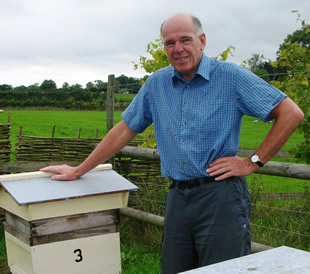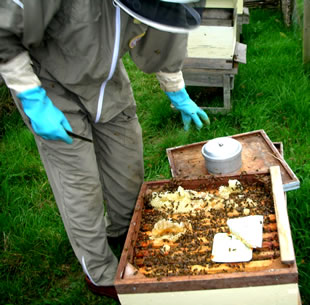A Bit About Bee Keeping
 The honey has been gathered – hopefully - from our hives, and we prepare them for winter. Having plundered what the poor bees have been storing all summer to see them through the winter, the beekeeper must give them back enough food to live on until they can forage again in the Spring. This is given to them in the form of a dilute syrup, 1 Kg of sugar to a litre of water, administered through a special feeder which we put on the top of the hive. It is surprising how much of this syrup they take; I am just buying my third 25Kg bag of sugar, shared between my 3 hives (Bookers, the wholesale suppliers sell sugar to bona fide beekeepers at a very good discount, this being their part in supporting bees and beekeepers).
The honey has been gathered – hopefully - from our hives, and we prepare them for winter. Having plundered what the poor bees have been storing all summer to see them through the winter, the beekeeper must give them back enough food to live on until they can forage again in the Spring. This is given to them in the form of a dilute syrup, 1 Kg of sugar to a litre of water, administered through a special feeder which we put on the top of the hive. It is surprising how much of this syrup they take; I am just buying my third 25Kg bag of sugar, shared between my 3 hives (Bookers, the wholesale suppliers sell sugar to bona fide beekeepers at a very good discount, this being their part in supporting bees and beekeepers).
A hive comprises a Broodchamber, in which the queen bee lays her eggs, and the nurse bees rear and feed them until it is their turn to go and forage. On top of the broodchamber we place Supers, shallower boxes of frames, in which we hope the bees will store nectar which they convert to honey. A device called a Queen Excluder is placed between the brood chamber and the supers so that the queen cannot lay her eggs (and grubs be reared) where the bees are storing honey on our behalf. As the name implies, this excludes the queen from the supers. As the honey-gathering season goes on, and the super hopefully fills up, we put further supers on top. Each super holds about 35lbs of honey when full. This year, after I had moved my hives to some field beans near my home in Horsington, one hive had 3 supers on it (though not all full), and the others had one or two. I have had a better year than usual, having harvested about 108lbs.
 For my first 3 years of beekeeping I had no honey at all. This was partly due to ignorance and poor management on my part. That was over 30 years ago, and I hope I have learned a bit since those days.
For my first 3 years of beekeeping I had no honey at all. This was partly due to ignorance and poor management on my part. That was over 30 years ago, and I hope I have learned a bit since those days.
A queen bee lives up to 3-4 years, but a worker only for 6 weeks. Some other interesting statistics:
- It is estimated that it takes about 2 million bee visits to flowers to fill a jar of honey.
- A jar of honey is the result of approximately 90,000 bee flights.
- A worker bee would gather in its life-time approximately ½ teaspoon of honey.
- A bee flies at about 8 Km/hour
- A worker bee visits 50-100 flowers on each trip.
Please don't ask me how these figures were arrived at!
There is so much I could tell you about beekeeping. It really is a most interesting and absorbing hobby. There is a thriving local beekeepers' association, which is affiliated to the Somerset Beekeepers Association. We are based around Wincanton-Bruton-Castle Cary, and our details can be found on the Somerset Beekeepers Assoc website. Or you can make contact, if you are interested in learning more about the craft, with one of the local beekeepers. There are quite a lot of us around! Or ask the writer of this article anytime; I'm always around (or nearly always).
Early last year a beehive was to be seen in among the prolific Dandelions on the roundabout at Anchor Hill. It was there for just under a month. You might have seen it. Many people wondered who would just do a thing like that. But more knowledgeable folk just said "who do you think it was?"
Bob Jones
President, South-East Division, Somerset Beekeepers' Association
Comments
Login to comment!